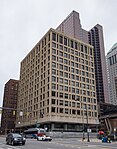LeVeque Tower

The LeVeque Tower is a 47-story skyscraper in Downtown Columbus, Ohio. At 555 feet 5 inches (169.29 m) it was the tallest building in the city from its completion in 1927 to 1974, and remains the second-tallest today. Designed by C. Howard Crane, the 353,768 square feet (32,866.1 m2) art moderne skyscraper was opened as the American Insurance Union Citadel in 1927 and at the time was the fifth tallest building in the world. Built at a cost of $8.7 million, the tower's design incorporated ornate ornamentation and a terracotta facade, and it was designed with 600 hotel rooms in two wings as well as an attached performance venue, the Palace Theatre. After American Insurance Union went bankrupt in the Great Depression, the tower was renamed the Lincoln-LeVeque Tower in 1946, and later the LeVeque Tower in 1977. The tower's office space saw mixed success in attracting tenants during its early history, but it became home to a number of state agencies and law firms. As development of downtown Columbus peaked from the 1960s and several other high rise buildings were constructed, the tower faced increasing competition from other major office buildings and its vacancy rates rose. Over the course of its history, the tower changed hands several times before being sold to a group of real estate investors in 2011. The current owners subsequently converted it into a mixed-use development including a hotel, apartments, condominiums, offices and a restaurant, which opened in 2017.
Excerpt from the Wikipedia article LeVeque Tower (License: CC BY-SA 3.0, Authors, Images).LeVeque Tower
West Broad Street, Columbus
Geographical coordinates (GPS) Address External links Nearby Places Show on map
Geographical coordinates (GPS)
| Latitude | Longitude |
|---|---|
| N 39.962375 ° | E -83.002086944444 ° |
Address
LeVeque Tower
West Broad Street 50
43216 Columbus
Ohio, United States
Open on Google Maps











